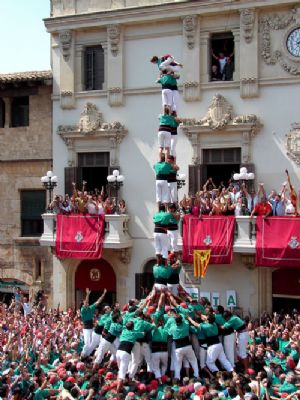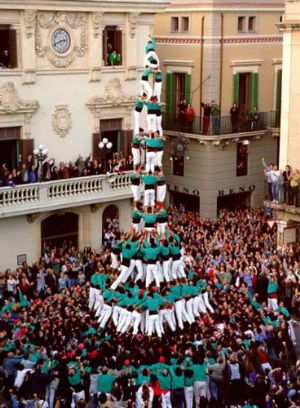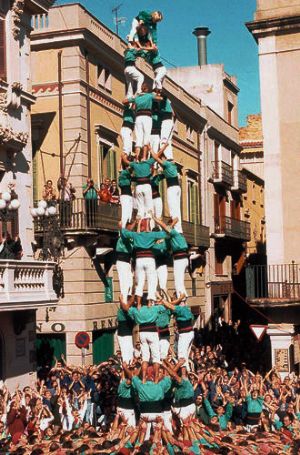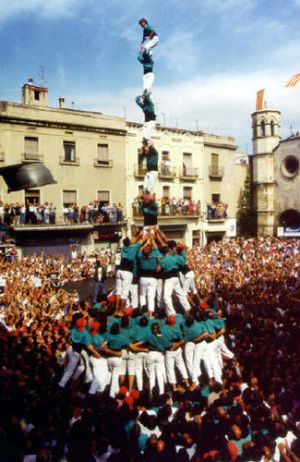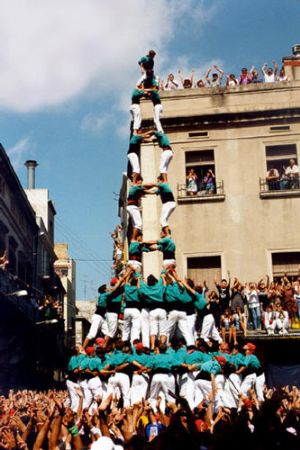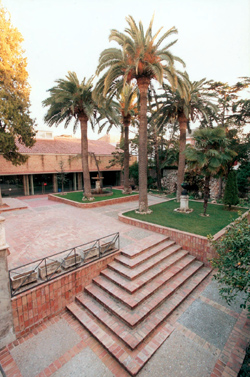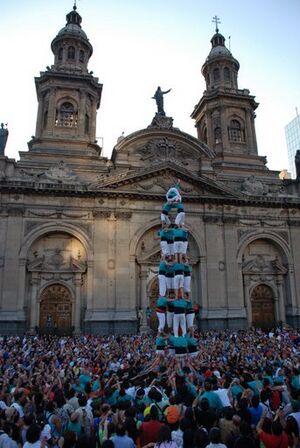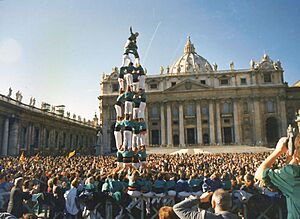Castellers de Vilafranca facts for kids
The Castellers de Vilafranca are a special group from Catalonia, Spain. Their main goal is to build amazing human towers, called castells. These towers are a cultural and sporting tradition. People work together to climb on each other's shoulders, forming tall, impressive structures.
Contents
History of the Castellers de Vilafranca
The Castellers de Vilafranca group started in September 1948. A person named Oriol Rossell founded it. People in Vilafranca del Penedès were very interested in building human towers. This tradition has been around since the 1700s, growing from a dance called "Ball de Valencians."
The group began by building towers that were seven levels high. They also made friends with other casteller groups. Oriol Rossell was the first cap de colla (leader or technical manager) from 1948 to 1952. Ramon Sala took over from 1953 to 1955. The group first wore rose-colored shirts, then changed to red.
In 1957, the group reorganized and chose green shirts, which they still wear today. From 1957 to 1968, they mostly built seven-level towers. Their highest achievement was the cinc de set. Between 1969 and 1974, they started building eight-level towers. These included the torre de set, quatre de vuit, tres de vuit, pilar de sis, and the torre de vuit amb folre.
In 1972, the group won the Human Towers Competition in Tarragona. This big competition happens every two years.
New Ways of Working (1975-1994)
In 1975, the group changed how it was run. Instead of just one leader, a team started managing the tower-building. In 1981, they decided that members would no longer be paid. This change caused some members to leave.
From 1975 to 1982, they often built eight-level towers. In 1985, they built their first cinc de vuit. In 1987, they achieved the first tres and quatre de nou amb folre (meaning the tower was built but collapsed during the take-down). By 1989, they successfully built and took down the first tres de nou amb folre. In 1990, they did the same with the quatre de nou amb folre. Carles Domènech was the cap de colla during this time, from 1975 to 1994.
Record-Breaking Towers (1995-2004)
Between 1995 and 2004, the Castellers de Vilafranca reached new heights. They successfully built and took down many difficult towers. These included the torre de nou amb folre i manilles, pilar de set amb folre, and pilar de vuit amb folre i manilles. They also built the quatre de vuit amb l’agulla and the quatre de nou amb folre i l’agulla, which was a first in human tower history.
They even built the cinc de nou amb folre. In an amazing feat, they built the tres and quatre de nou amb folre at the same time. This was the first and only time this has happened in human tower history. They also built some very difficult towers that were completed but then collapsed during the take-down. These included the torre de vuit, quatre de nou, and the tres de deu amb folre i manilles, which was another first.
The group won the Tarragona Human Towers Competition many times: in 1996, 1998, 2002, 2004, 2006, 2008, 2010, and 2012. In 2005, the Castellers de Vilafranca built the torre de nou amb folre. This is considered one of the hardest towers ever built by any group.
Francesc Moreno "Melilla" was the cap de colla from 1995 to 2003. Lluís Esclassans led from 2004 to 2007. David Miret became the new cap de colla in December 2007. By 2010, the Castellers de Vilafranca had about 400 active members.
Amazing Castells They've Built
The Castellers de Vilafranca have built many incredible human towers throughout their history. Here is a list of some of their most important achievements. "Descarregat" means the tower was built and taken down successfully. "Carregat" means the tower was built, but it collapsed while being taken down.
| CASTELL | Descarregat (successfully dismantled) |
Carregat (collapsed in dismantling) |
|---|---|---|
| Tres de nou amb folre i agulla | 31 Aug 2009 | |
| Torre de nou amb folre | 30 Aug 2005 | |
| Tres de deu amb folre i manilles | 15 Nov 1998 | |
| Quatre de nou amb folre i tres de nou amb folre simultanis | 31 Aug 2001 | |
| Torre de vuit neta | 1 Nov 2010 | 1 Nov 1999 |
| Quatre de nou | 1 Nov 2002 | |
| Quatre de nou amb folre i agulla | 1 Nov 1996 | 1 Nov 1995 |
| Cinc de nou amb folre | 1 Nov 1997 | 30 Aug 1997 |
| Pilar de vuit amb folre i manilles | 28 Sep 1997 | 31 Aug 1995 |
| Torre de nou amb folre i manilles | 30 Aug 1995 | |
| Tres de nou amb folre | 30 Aug 1989 | 31 Aug 1987 |
| Quatre de nou amb folre | 1 Nov 1990 | 1 Nov 1987 |
| Quatre de vuit amb l'agulla | 8 Oct 1995 | |
| Cinc de vuit | 30 Aug 1985 | |
| Torre de vuit amb folre i pilar de set amb folre simultanis | 31 Aug 2006 | |
| Pilar de set amb folre | 1 Oct 1995 | 14 May 1995 |
| Tres de vuit amb agulla | 29 Aug 1996 | |
| Dos pilars de sis simultanis (un de carregat) | 31 Aug 2001 | |
| Torre de vuit amb folre | 17 Nov 1974 | 12 Oct 1973 |
| Tres de vuit | 30 Aug 1974 | 1 Oct 1972 |
| Pilar de sis | 30 Aug 1972 | 19 Dec 1971 |
| Quatre de vuit | 30 Aug 1971 | 12 Oct 1969 |
| Nou de set | 11 Dec 1988 | |
| Torre de set | 24 Aug 1969 | |
| Tres de set aixecat per sota | 25 Nov 1973 | |
| Sis de set | 21 Jan 1997 | |
| Cinc de set amb agulla | 19 Apr 2008 | |
| Cinc de set | 26 Sep 1965 | 30 Aug 1965 |
| Tres de set amb l'agulla | 10 Aug 1996 | |
| Quatre de set amb l'agulla | 5 Aug 1954 | 31 Aug 1953 |
| Tres de set | 31 Aug 1949 | |
| Quatre de set | 31 Aug 1949 | |
| Torre de sis | 16 Jun 1949 | |
| Pilar de cinc | 14 Sep 1948 |
Cal Figarot: The Group's Home
Cal Figarot is where the Castellers de Vilafranca group meets and practices. It's a beautiful building with a neogothic style, built in the late 1800s. The group bought it in 1983. Later, in 1998, they bought a building next door. Both buildings were fixed up. The new building has a large open space, about 600 square meters. This big space is perfect for their training sessions.
Castellers de Vilafranca Around the World
The Castellers de Vilafranca have traveled to many countries to show off their human towers. They have performed in places like France, Italy, Germany, the Netherlands, Belgium, Denmark, Chile, India, and even New York City!
In 1988, they performed in Italy to celebrate 1,000 years of Catalonia. They also performed at the Universal Exposition Seville'92 in 1992. In 2010, they were in Brussels, Belgium, to support the idea of human towers becoming a UNESCO World Heritage. The Castellers de Vilafranca also performed at the opening ceremony of the Olympic Games in Barcelona in 1992.
The group has also toured a lot in the Països Catalans. These are areas where Catalan is traditionally spoken.
- They performed six times in Perpignan, France (1970, 1977, 1982, 1989, 1997, 1998). They also visited other towns in Northern Catalonia.
- They visited Andorra four times, performing in different cities there.
- They had two tours in the Valencia Region of Spain. They performed in cities like Alcoi, Benidorm, and Alicante.
- They toured Palma, Majorca, in 1980 and Manacor, Menorca, in 2001.
- They also visited Alghero, Italy, in 1978.
Images for kids
See also
 In Spanish: Castellers de Vilafranca para niños
In Spanish: Castellers de Vilafranca para niños


